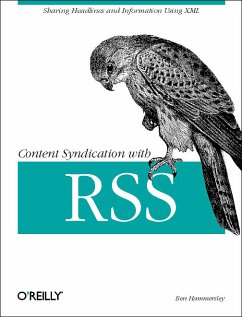RSS is sprouting all over the Web, connecting weblogs and providing news feeds. Originally developed by Netscape in 1999, RSS (which can stand for RDF Site Summary, Rich Site Summary, or Really Simple Syndication) is an XML-based format that allows web developers to describe and syndicate web site content. Using RSS files allows developers to create a data feed that supplies headlines, links, and article summaries from a web site. Other sites can then incorporate them into their pages automatically. Although RSS is in widespread use, people struggle with its confusing and sometimes conflicting documentation and versions. Content Syndication with RSS is the first book to provide a comprehensive reference to the specifications and the tools that make syndication possible.
Content Syndication with RSS offers webloggers, developers, and the programmers who support them a thorough explanation of syndication in general and RSS in particular. Written for web developers who want to offer XML-based feeds of their content, as well as developers who want to use the content that other people are syndicating, the book explores and explains metadata interpretation, different forms of content syndication, and the increasing use of web services in this field.
This concise volume begins with an introduction to content syndication on the Internet: its purpose, limitations, and traditions, and answers the question of why would you consider "giving your content away" like this? Next, the book delves into the architecture of content syndication with an overview of the entire system, from content author to end user on another site. You'll follow the flow of data: content, referral data, publish-and-subscribe calls, with a detailed look at the protocols and standards possible at each step. Topics covered in the book include: * Creating XML syndication feeds with RSS 0.9x and 2.0
* Beyond headlines: creating richer feeds with RSS 1.0 and RDF metadata * Using feeds to enrich a site or find information
* Publish and subscribe: intelligent updating
* News aggregators, such as Meerkat, Syndic8, and Newsisfree, and their web services * Alternative industry-centric standards
If you're interested in producing your own RSS feed, this step-by-step guide to implementation is the book you'll want in hand.
Content Syndication with RSS offers webloggers, developers, and the programmers who support them a thorough explanation of syndication in general and RSS in particular. Written for web developers who want to offer XML-based feeds of their content, as well as developers who want to use the content that other people are syndicating, the book explores and explains metadata interpretation, different forms of content syndication, and the increasing use of web services in this field.
This concise volume begins with an introduction to content syndication on the Internet: its purpose, limitations, and traditions, and answers the question of why would you consider "giving your content away" like this? Next, the book delves into the architecture of content syndication with an overview of the entire system, from content author to end user on another site. You'll follow the flow of data: content, referral data, publish-and-subscribe calls, with a detailed look at the protocols and standards possible at each step. Topics covered in the book include: * Creating XML syndication feeds with RSS 0.9x and 2.0
* Beyond headlines: creating richer feeds with RSS 1.0 and RDF metadata * Using feeds to enrich a site or find information
* Publish and subscribe: intelligent updating
* News aggregators, such as Meerkat, Syndic8, and Newsisfree, and their web services * Alternative industry-centric standards
If you're interested in producing your own RSS feed, this step-by-step guide to implementation is the book you'll want in hand.

